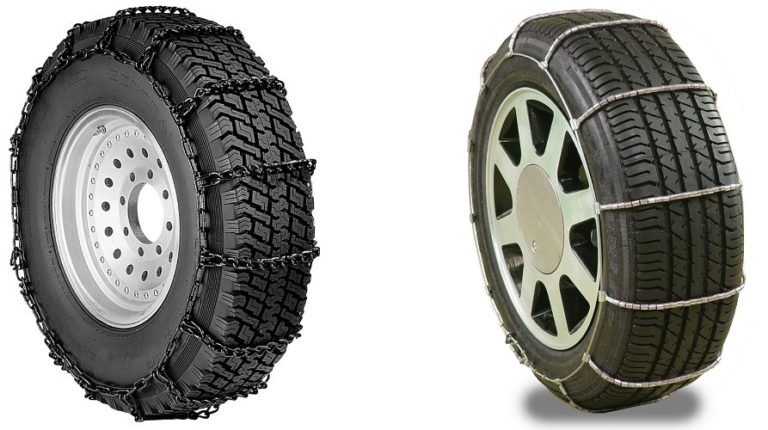Note: I originally wrote this article for the now retired outdoorus.website. An archived copy of the post can be viewed here. Affiliate links are present in this article.
The diversity of the US means that some people at some times are going to need to do some driving in the snow. If you live in a city you may be able to get away with your all seasons, but for those heading out on a ski trip, or who live out of a plough zone, a set of chains are critical. While certain states have legal requirements for tire traction devices (check your local DMV website), always use some common sense when driving as to whether a set of chains will be beneficial or not.
What are termed ‘tire traction devices’ come in many different varieties, beyond the well-known snow chains; cables, spikes and other devices are also available. While they all have their application, the most popular and universal are tire chains and tires cables, so how does one go about choosing?
What is the difference?
Both devices have the same goal, to improve your traction on snowy roads, but have a different design. Snow chains are the most well-known, they are literal chain links that are linked to create a mesh that you can wrap around your tire. Cables are slightly lower key, and are made from strands of steel cable that create a web covering your tires. Usually additional small metal rings are looped onto the cables to provide additional grip.
What to Consider
Clearance
A limiting factor to what you can install on your vehicle is its clearance. While most SUVs and pickups have plenty of space around the wheel arch to accept any type of chain or cable, certain vehicles, especially sedans and hatchbacks with low ground clearance also have minimal clearance in the wheel arch. This not only makes installation difficult, but if you were to install chains, may result in damaging your vehicle.
Check how much space there is around your wheels, and consult your owner’s handbook for recommendations. If you are concerned about the amount of space, you should definitely go with a set of snow cables. They have a much lower profile than snow chains and are less likely to damage your vehicle if slightly loose.
How much snow
The next thing to consider is the amount of snow you’re going to be driving in. If it’s just a few inches, snow cables are more than capable. But if you’re going to be driving in much more than that then you definitely want a set of chains. The more snow there is, the thicker the type of traction device you want. Cables are relatively thin by design, which means they can’t get you through as much snow as a solid set of chains.
How much Use
You also need to consider how much you’re going to be using the device, and how far you are going to have to travel. If you’re not expecting to use them very often, and only for a couple miles, then cables are more than adequate. If you are going to be using these several times a week and covering tens of miles each time, chains are more durable and will provide you with a longer life. Some of the more expensive cables are also designed for extended use, but expect to pay for the extra quality.
Price
The cost of snow chains can vary a lot. If you know you’re going to be travelling in an area that may experience snow, buy a set ahead of time. If you have to buy chains last minute in an area that’s just had snow, chances are the prices will be high, especially if you have an uncommon tire size. Otherwise cables are usually the cheapest. We’ve discussed the compromise you will make buying cables over chains, and if you’re expecting to get lots of use out of a set, you should definitely pay extra for a good set of chains.
In the grander scheme of things they are not particularly expensive, with very good products available for much less than $200. This for a product that you can use repeatedly for a long time.
How many do I buy
Chain sets are usually sold in pairs. Most states and vehicle’s owner manuals recommend that a single set of snow chains be installed on the driving wheels. For a FWD vehicle, this will be your front wheels, and for a RWD vehicle your rear wheels. If you have a 4×4 or AWD vehicle you can place them on either set, and for extreme conditions installation on all four wheels is usually permitted.
Recommended Products
Now that you know what type of product you want to buy, you’re still left with choosing between many different products that will fit your car. To help you out, we’ve selected two chain sets and two cable sets to get you started on the search. All products come in different sizes, so be sure to check your car’s tire sizes before purchasing a set of chains.
A relatively cheap set of no fuss tire cables. A simple design with easy installation. Depending on requirements you may want to opt for an additional tensioning cable.
Security Chain Company Quik Grip Tire Chains
A solid set of tire chains, mainly for larger vehicles. Very well rated at a decent price.
Security Chain Company Tire Cable
A moderately priced set of cables with angular traction pattern providing slightly improved traction. The set includes a built-in rubber tensioner, requiring less attention while driving. Very good customer reviews.
If you’re looking for quality, Thule is a big name in outdoor equipment and their Konig snow chains are no different. While quite pricey, they still come in under $200 (for most tire sizes) and include a 5 year warranty. Good traction pattern with self-tensioner. Top choice if you’ll be making regular trips.
Conclusion
A tire traction device is a must for anyone who needs to do some driving in snow, even if just a few inches are present. Whatever type you decide, be sure to install your traction device soon after you purchase them and ensure they fit properly, and that you know how to install them. Putting them on in the snow, when you’re in a hurry is not a fun experience, made worse by ill-fitting chains. Chains are not one-size-fits-all, so you will have to check a manufacturer’s model table to determine what product is suitable for your tires. With this knowledge of the differences between tire chains and tire cables, you have no excuse to get outdoors this winter.











